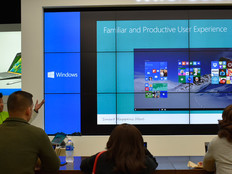CompTIA: Small Businesses Want Laptops, Productivity Apps and Network Gear
Technology providers that sell products and services to small- and medium-sized businesses likely want to know: What are those SMBs buying when it comes to IT, and how does a company’s size affect its purchases?
According to recent research from IT industry trade group CompTIA, the SMB IT market is vast and diverse. Tim Herbert, senior vice president of research and market intelligence at CompTIA, noted recently to TechTarget that the small-business market ranges from one- and two-person outfits to 500-employee companies.
Speaking last month at the organization’s annual member meeting in Chicago, Herbert noted that CompTIA sees the SMB market as having three distinct subcategories. The largest of these is “budget conscious” companies, which represent 78 percent of the roughly 9 million small businesses in the United States.
According to Herbert, this part of the SMB market tends to make IT purchases for devices or services that are broken or need to be fixed, as well as must-have services like web design, reports TechTarget.
Meanwhile, there are what CompTIA refers to as “competitive targets,” or firms with 100 to 500 employees. These firms make up just 2 percent of the SMB market, according to CompTIA, and they tend to have larger IT budgets and a “pretty sophisticated internal IT capacity,” Herbert said.
In the middle are “sweet spot” companies — small businesses with 10 to 99 employees. They represent 20 percent of the market, but that still winds up being 1.8 million small businesses. What are they like? As TechTarget reports: “Presumably, the sweet spot companies have money to spend on IT, but smaller or non-existent IT departments —factors that make this group more dependent on external providers of small business IT services.”
Which IT Purchases Matter to Small Businesses?
What kinds of technologies most appeal to small-business owners and IT decision-makers?
According to TechTarget, a CompTIA online survey of 600 U.S. SMB executives and professionals found desktop and laptop computers, productivity and office applications, and networking equipment were the top three purchase areas.
Resellers and technology partners capture 22 percent of the SMB market’s IT spending, while local retailers (22 percent), online-focused retailers (25 percent) and direct-sales vendors (30 percent) take up the rest of the pie.
How will the rest of this year play out in terms of SMB IT spending and priorities? They will largely be driven by business priorities. CompTIA found that the top three business priorities for SMBs are renewing or maintaining key customer accounts, identifying new customers and markets, and implementing new systems or work processes to enhance efficiencies.
What’s Ahead for the Small-Business IT Market?
Interestingly, according to CompTIA’s “IT Industry Outlook 2017” report, there is a range of perceived shortcomings among SMBs on the return on investment of technology expenditures.
“Somewhat paradoxically, 4 in 10 SMBs indicate they believe their level of spending on technology is too low,” the report notes. “The takeaway: there is work to be done to bridge the disconnects between technology providers and users.”
The report adds, “In the past, technology served more of a supporting function, especially at the SMB level. IT equipment and operations served the needs of business units, which in turn drove business results. As such, IT took on qualities of a cost center, where the notion of support was a fixed quantity and providing that support at lower costs was a common goal.”
However, over time, businesses have moved to a much more strategic view of IT. “The correct application of technology can enhance productivity, provide insights, or create new revenue opportunities,” the report notes. “IT now has to take an approach that considers broad business demands, especially as various business units are able to drive their own technology initiatives. Businesses today are starting to recognize the critical role that technology plays in advancing corporate objectives.
“Nearly every goal — from identifying new customers to hiring a skilled workforce to exploring new products — now requires technology to move forward at a modern pace. Companies may have originally viewed transformation as an avenue for growth, but it is becoming a requirement for survival.”
Yet the report found that only 28 percent of companies are “extremely confident” in their ability to apply modern technology to their business goals, with the smallest firms trailing medium-sized and larger corporations in their internal assessments. (Fully 45 percent say they are “highly confident,” 25 percent say they are “somewhat confident” and 2 percent are “not confident.”)
“Becoming a digital organization certainly involves a wide range of skills. Foundational layers like networking, security, and application development lead to more advanced tactics such as cloud architecture, risk analysis, and mobile optimization,” the report says. “And that’s just the IT department—business units are quickly increasing their digital literacy as they own larger pieces of the puzzle.”









